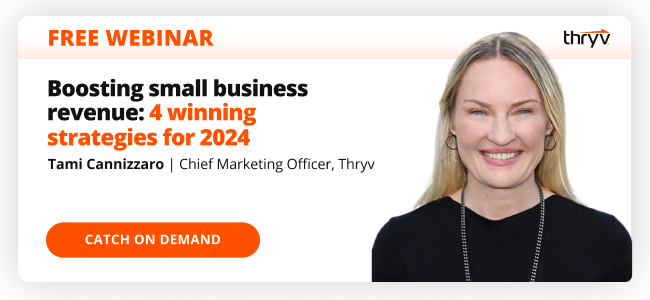Just because 2023 is winding down, your small business shouldn’t. If this year was less than perfect, consider using the remaining weeks to build a marketing strategy for an even stronger 2024 with help from Tami Cannizzaro, Thryv’s Chief Marketing Officer.
In our latest webinar, Cannizzaro incorporates decades of marketing expertise in her 4-step plan for you to engage with current and prospective customers, put your best foot forward online and position your marketing strategy to boost revenue.

Marketing Center: Small Business Marketing Made Easy
Learn MoreStep 1: Marketing Promotions
Convincing anyone to act might be the single hardest thing for a business owner to do. After all, you’re sort of controlling a customer’s will to choose you. Cannizzaro offers three types of marketing promotions that can help – limited-time offers, bundle pricing and loyalty programs.
Limited-Time Offers
Putting a time limit on your offer helps customers to act because they feel they’ll miss out if they don’t. Create a sense of FOMO with offers that are “for this week only,” or “for your birthday month only.”
Bundle Pricing
Who loves a good value or getting something for free? Spoiler alert! Everyone. Consider bundling multiple services for a discounted price. You can also drive awareness and reveal the benefits of new services by offering them for free when customers book their normal service.
Loyalty Programs
It’s important to communicate and regularly engage to make customers feel valued. Loyalty programs accomplish this through perks and special offers. Additionally, providing your customers meaningful and valuable information reinforces their worth.
Step 2: Customer Referral Programs
Referral programs are one of many linchpins for a small business marketing strategy. This tit-for-tat mentality is how you mobilize current customers and transform them into word-of-mouth specialists.
Your best chance of increasing revenue is by dipping into your already-loyal customer base.
Here are a few ways to activate those loyal customers:
- Referral Incentives: This can be a free service, financial gift or discounts. Make the incentive worth their while so they feel empowered to spread the word about your business to their friends and family.
- Ambassador Programs: Brand ambassadors are all about providing advocacy for your business. They’re typically your best customers and are easily compelled to bring in new business because of the stellar experience you routinely provide.
- Influencer Partnerships: Some customers tend to trust their peers rather than advertisers, especially younger generations. Reach these customers by partnering with influencers who can share your services and business ideas with their followers.
Step 3: Social Media Marketing
You must make social media a priority in your marketing strategy, Cannizzaro notes. Consumers don’t just go to Google anymore, they check your Facebook, Instagram and other platforms where you have a presence.
55% of consumers learn about new brands from social media.
Based on your social media profile, visitors should be able to get a sense of who you are and what a vendor/customer relationship would be like if they were to engage.
Obviously, all your information needs to be correct all the time and your page should be an accurate representation of your brand, from your profile picture to the content you post. Include your business story, show happy customer photos, tout 5-star reviews and anything else that provides an opportunity for customers to engage.
Paid advertising is another social media marketing strategy Cannizzaro strongly urges business owners to consider. And you don’t even have to spend a ton of money. Boosted Facebook posts start as low as $5.
The secret to paid social ads is thinking through your customers’ pain points. Don’t just advertise your services, advertise the value that you bring.
Social media can seem like an unscalable mountain when you’re juggling a million other tasks, but using AI tools to generate ideas can maximize time so you’re not wasting the day trying to think of something clever to post.
Step 4: Get Found Online
The first step to getting found online is being online. A website alone is not enough. You also need a a Google listing, an aforementioned social media presence and some paid ads to work together to build a credible online presence.
Local SEO is another important piece of the marketing strategy puzzle. Positioning your business within your locale will help you show up in “near me” searches, says Cannizzaro. Make sure to include local SEO on all your online touchpoints to ground your business in the areas you serve.
Lastly, use quality content to attract customers and keep them on your website. This is another way to build authority in the eyes of search engines and consumers.
It’s also an opportunity to utilize AI tools for content ideas and even the content itself whether it’s blogs, Google Business Profile information, website copy and more.
It’s Never Too Early to Strategize
Without a marketing strategy in place, it’s easy to get sidetracked and lose sight of your business growth goals, especially as your business pulls you in many different directions.
Watch Tami Cannizzaro’s webinar for more tips to boost your small business revenue in 2024.









